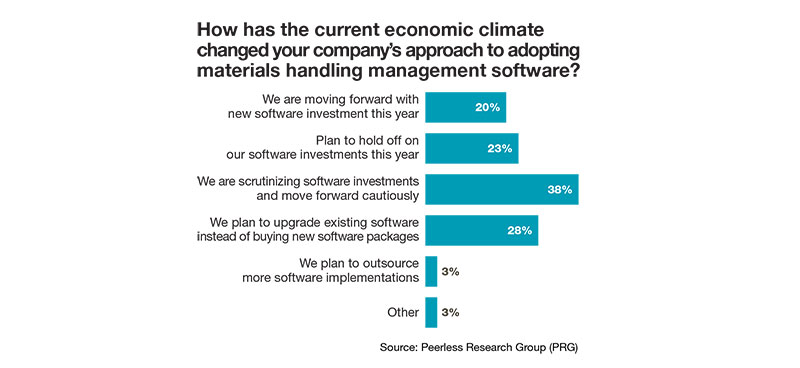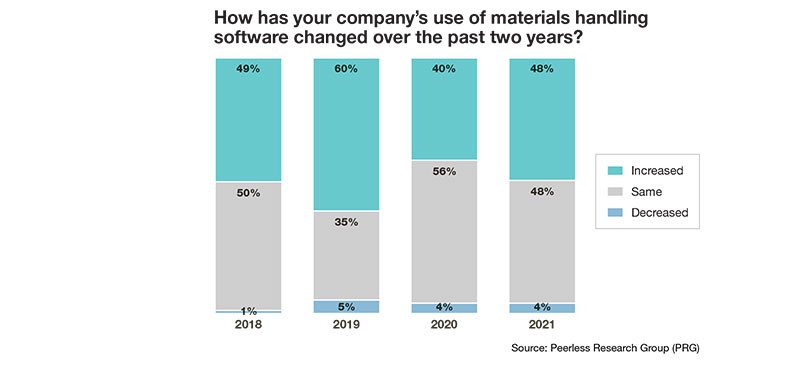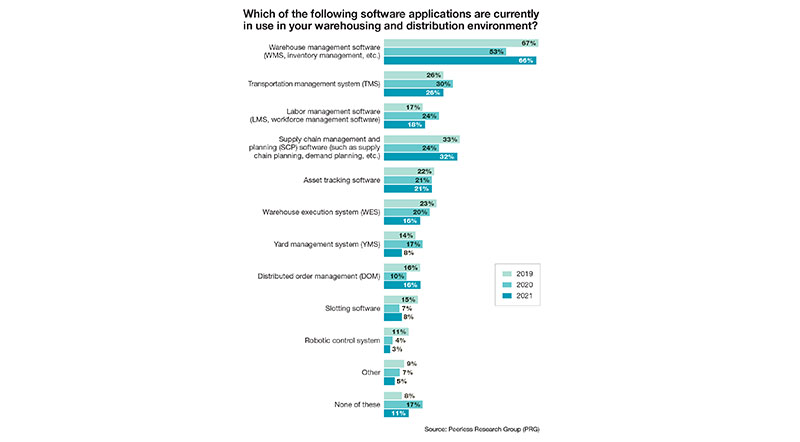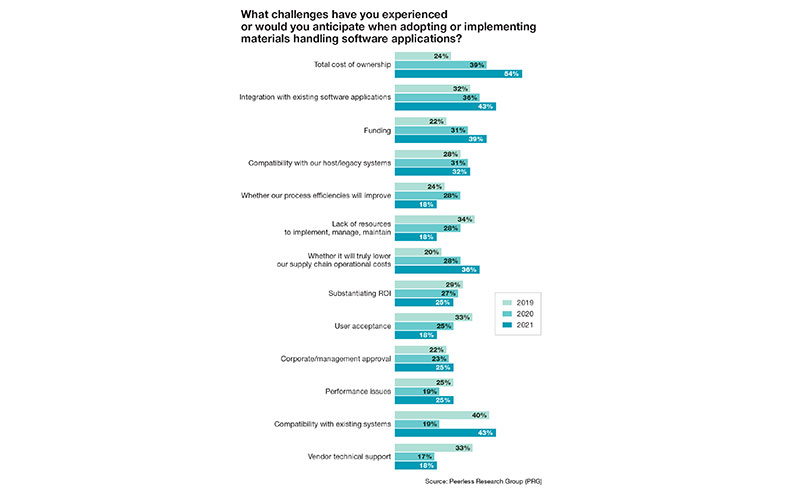Software Survey 2021: Goodbye hesitancy, hello resiliency
Our annual reader survey found a nearly 20% drop in respondents holding off on software investments compared to the previous year when readers were struggling through the early months of the pandemic. Our 2021 report shows strong interest in inventory and labor management capabilities.
Our annual technology and software survey is out, and much of the hesitation that existed in moving forward with software last year has subsided. The 2021 survey, conducted in April of this year, shows that a much smaller slice of respondents are holding off on software investments compared to 12 months previous—as might be expected, given the timing of the 2020 survey during the early months of pandemic.
Now with public health and the economy improving, readers report less hesitancy when it comes to deploying the types of supply chain and warehouse-focused software covered in the survey. Readers tell us they are after better inventory control, and better efficiency and flow for their warehouse operations. In asking about two-year plans, certain categories of software such as slotting and labor management showed increased interest.

This year’s survey saw current use of warehouse management system (WMS) solutions back on the rise, 1% off our survey from two years ago. Additionally, when it comes to two-year plans to evaluate, purchase or upgrade WMS, that percentage climbed by 10% versus last year.
Modern Materials Handling’s “2021 Materials Handling Technology Study” was conducted by Peerless Research Group (PRG) and surveyed Modern subscribers. Respondents shared their views of current software usage, returns on investment, and key goals related to their software purchases.
The usage survey covers a range of applications to manage warehouse processes and execution, as well as higher level supply planning and execution functions. The purview of the survey spans everything from WMS and warehouse execution systems (WES) software for DCs, to functions such as supply chain planning, demand planning, distributed order management (DOM) software, as well as transportation management software (TMS).

Of the 100 readers who participated in the study, 7% are corporate or divisional managers, 30% are vice presidents or general managers, 11% are logistics or distribution managers, and 7% are warehouse managers.

Thirty three percent work for companies with less than $10 million in sales and 15% from firms with $10 million to $49.9 million in annual sales. However, 7% are with companies with $2.5 billion or more in annual revenues, and another 7% are with the companies with annual sales of $1 billion to $2.49 billion. The average annual revenue for respondents’ companies was $452 million, with a median of $30 million. Respondents are spread across multiple industries, with the most in manufacturing (48%), 11% in either retailing or wholesaling, and 15% in third-party logistics (3PL) services.
Approach and uptake
When asked about their company’s approach to the adoption of technology, the largest percentage of respondents (35%) said they cautiously embrace change. Five percent considered themselves tech innovators, while 15% identify as early adopters. On the other end of the spectrum, 18% take a “wait-and-see” approach and 27% were the last to adopt new technologies.
The “cautious middle” approach to technology isn’t new with our annual survey. What is new versus last year is that we aren’t in the earlier trajectory of pandemic like we were in spring of 2020.
When our 2020 software usage survey was fielded in April 2020, there was an understandable caution underway for many companies. The findings for 2021 show a return to a more robust rate of software use and evaluation, likely tied to the waning of the pandemic and improved economic conditions.
For example, when asked how the current economic climate has changed the approach to adopting software, last year, 41% said they plan to “hold off” on investments. By contrast, this year, that answer plummeted to 23%. Additionally, this year, 20% are moving forward with new software investments, 38% are scrutinizing investments and moving forward cautiously, 28% plan to make upgrades instead of buying new applications, and 3% will outsource more software implementations.
When asked how “has your company’s use of software changed over the past two years,” this year, 48% said it increased, up from 40% last year. Another 48% this year say software use has stayed about the same, compared to 56% last year; and 4% report a decrease this year, same as in 2020. The big change here is the 8% rise in respondents saying software use is on the increase, though below the 60% who said it was on the increase two years ago in the 2019 survey.
On average, respondents will spend $359,260 on supply chain software over the next 12 months, up from last year’s average of $309,100. The median spend in 2021 will be $82,550, up from last year’s median of $69,230.
For most respondents (71%), software installation and integration work involves in-house staff, while other options include a software supplier (43%), a systems integrator (29%), or a business management consulting firm (14%).
The hottest apps
When asked which software applications are currently in use in their DC environments, the highest percentage of readers (66%) are using a warehouse management system (WMS), up from 53% last year, and nearly the same as the 67% response two years ago. This likely reflects some pandemic-related curbing of plans last April, with WMS plans and activity getting back into a more normal pattern.
Other categories on the upswing from last year when it comes to current use include supply chain planning, in use by 32% this year, up from 24% last year, and nearly the same as the 33% two years ago. Distributed order management (DOM), a category of software crucial for omni-channel fulfillment, is in use for 16% this year, up from 10% last year.
Additionally, for 2021, 26% of respondents are using transportation management systems (TMS), 18% use labor management systems (LMS) or workforce management solutions, and 16% use warehouse execution systems (WES), a category of software that sits between WMS and automated systems to handle issues like order release and orchestration of material flow.
When it comes to 24-month plans across these categories of software, 47% have plans to purchase, upgrade or evaluate WMS, up 10% from last year. Other application categories on the upswing over the next two years include LMS (24% have plans, compared to 14% in 2020), WES (21% have plans, vs. 14% in 2020), slotting (16% have plans, up by 10%), and TMS (18% have plans, up 7%).
With a resurgent, e-commerce- driven economy, upgraded or new WMS solutions should help with inventory control and accuracy, while WES is crucial when it comes to ensuring that warehouse fulfillment stays on track.
When it comes to drivers for WMS, there are multiple reasons, including use of modules in areas like labor or yard management. This year, 43% cite inventory deployment as a key WMS driver, 38% are after real-time control, 33% said new picking requirements, and 29% cited labor management and slotting, respectively. The top driver, at a 48% response this year, is the need to upgrade an existing WMS, up from 33% last year. It may be that in the depths of the pandemic in spring of 2020, some companies put a temporary halt on upgrades, but this year, more are proceeding to get onto newer WMS versions.

Asked how long it took to realize a return on their WMS investment, 36% of readers say they either haven’t yet—or they don’t know the answer to that question. Twenty-three percent said it took 12 to 18 months to realize a return, and 23% said more than 18 months. And 9% said ROI was achieved in six to nine months, and another 9% last less than six months.
As mentioned, among 2021 respondents, 26% use TMS, down from 30% in 2020. However, this year, 18% say have plans to evaluate or purchase TMS over the next two years, which is up from 11% last year.
According to our 2021 survey, a total of 66% have had their TMS in place for less than 10 years, while 22% have had their TMS solution in place for 10 to 15 years. And 12% have been using their current TMS for more than 15 years.
With labor availability continuing to be a top challenge for warehouse operations, and e-commerce showing few signs of slowing, DC operations are clearly interested in maximizing the productivity of existing labor.
Multiple applications can help with labor productivity, but LMS is uniquely focused on monitoring the productivity of warehouse labor and allowing warehouse associates and managers see how individual workers and the staff as a whole are doing with metrics like units shipped per hour.
It’s no surprise then that LMS will be purchased or evaluated by 24% of respondents over the next 24 months, which is 10% higher than last year. Additionally, when readers were prompted for ad-hoc comments, typical drivers mentioned included “throughput and efficiency,” as well as a need to “optimize people efficiency.”
Annually we also ask about challenges in adopting warehouse and supply chain software solutions. Areas of concern that were on the rise included total cost of ownership (cited by 54% this year, up from 39% last year) as well as integration with existing software systems, cited by 43%, up from 36% in 2020. While readers showing growing interest in many categories, the onus is on vendors to make adaption as pain free as possible.
Cloud gets mainstream
Cloud-based software is practically the norm for business applications like human resources software or office apps. When it comes to supply chain and warehouse-focused software, Cloud may not quite yet be the norm, but it’s getting there.

This year, 36% report they now run Cloud-based solutions, while another 36% are currently evaluating Cloud solutions or will be within 12 to 24 months. That means that combined 72% of respondents are either already on Cloud-based solutions, or considering them, which is the highest level for these two choices over the last three years.
For 2021, 60% are using or planning to evaluate Cloud-based applications for WMS, TMS, LMS, slotting, order management or planning, which is 1% higher than last year. Forty-seven percent want to use the Cloud to monitor systems, manage information and predict system failures for automated warehouse equipment. Additionally, 21% are using or planning to evaluate Cloud solutions to manage or collect data on their lift truck fleets, which is up by 6% from last year.
In rating the benefits of Cloud applications, the leading responses were better visibility (cited by 45%), easy to implement, deploy or upgrade apps (also cited by 45%), followed by “everyone has access to the same data,” named by 40%, and to run e-commerce apps, cited by 35%.
Enabling technologies
The annual survey asks about the technologies of machine learning (ML), artificial intelligence (AI), Big Data, and the Internet of Things (IoT) in light of how these enabling technologies are increasingly used either within packaged supply chain or warehouse-focused software solutions, or employed on a more custom basis.
Current adoption rates are relatively low for these technologies, but generally, compared to last year, there is rising interest in evaluating these technologies, especially over the longer term.
For example, when asked about their use of AI, 4% of respondents are now using AI, another 14% will consider it over the next two years, and 25% will evaluate AI, but are not sure when. The result tracks fairly close to last year, with a 1% higher response for “now evaluating,” but a 12% increase on those who say they will look at AI at some point, but are not sure when.
That increase in longer term interest is even higher when it comes to IoT. This year, 32% say they will evaluate IoT but aren’t sure when, compared to 15% last year.
When it comes to Big Data, 18% of respondents said they are now using Big Data in their operations, and a combined 14% are either considering it now or plan to in the next two years. Additionally, 29% said they would evaluate Big Data, but are unsure when, compared to 17% for this answer a year ago.
Overall, the survey results on enabling technologies are line with the survey’s other key findings. With more respondents this year saying their companies are moving forward with software investments, it stands to reason that more companies are going to be evaluating enabling technologies like AI and Big Data.
It may be that some readers do not even realize that their packaged application vendors are in some cases leveraging some of these technologies within their software. But whether incorporated into vendor packages, or pursued as part of more custom projects, these enablers can be seen as part of what it takes to make supply chains and warehouse operations more flexible, resilient, and better able to keep pace with the growth of e-commerce.





















